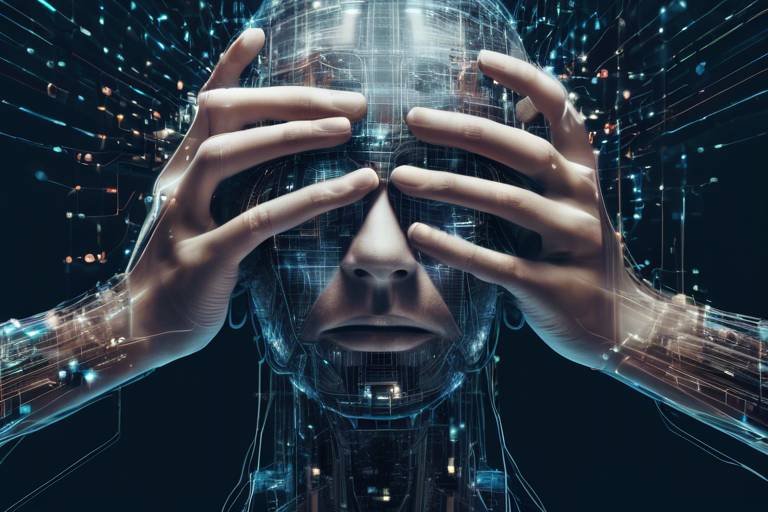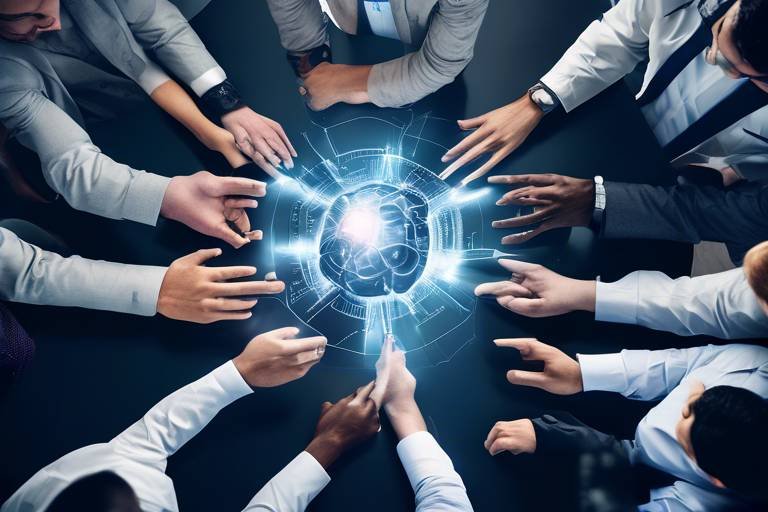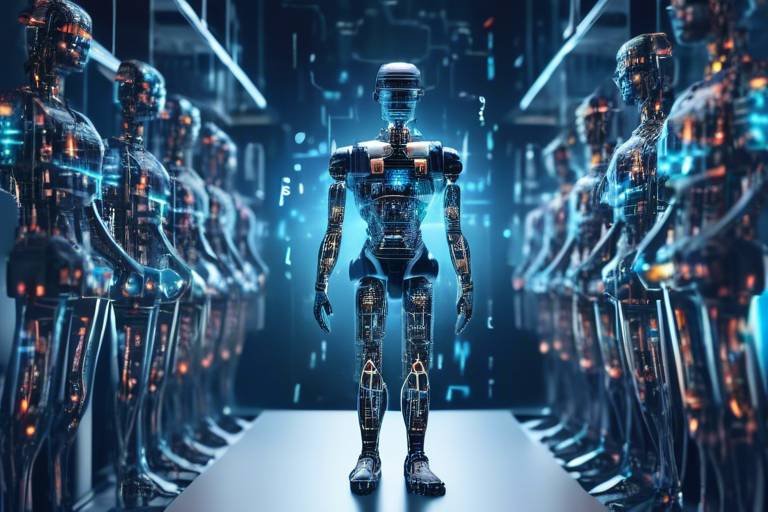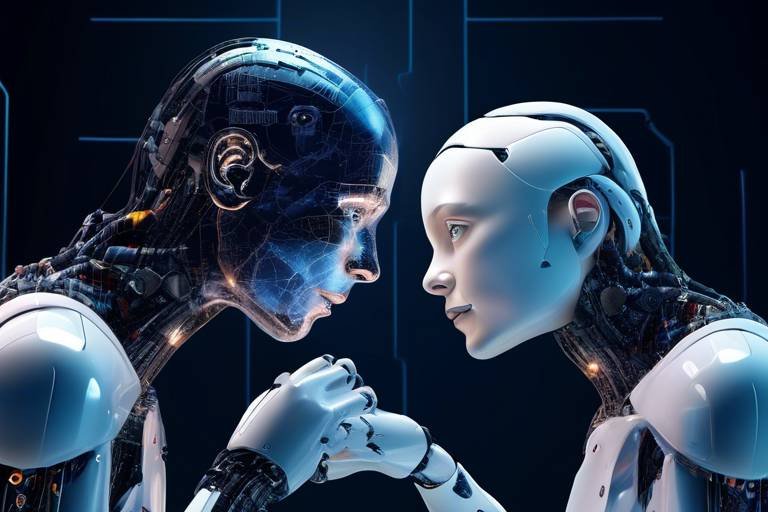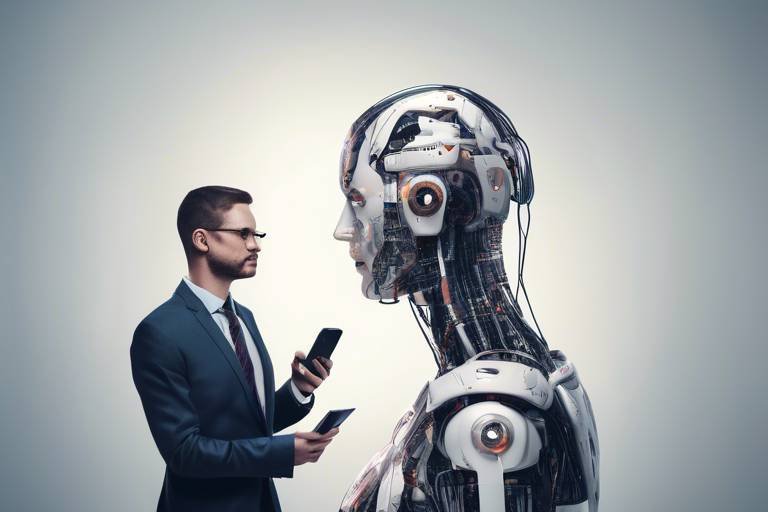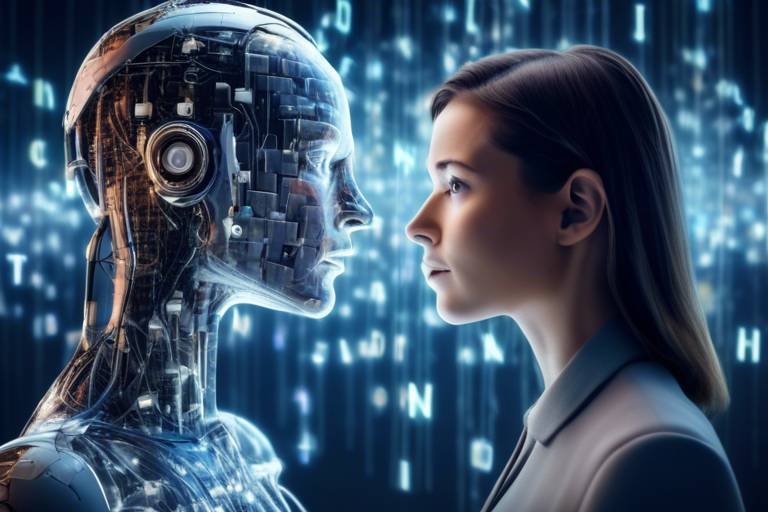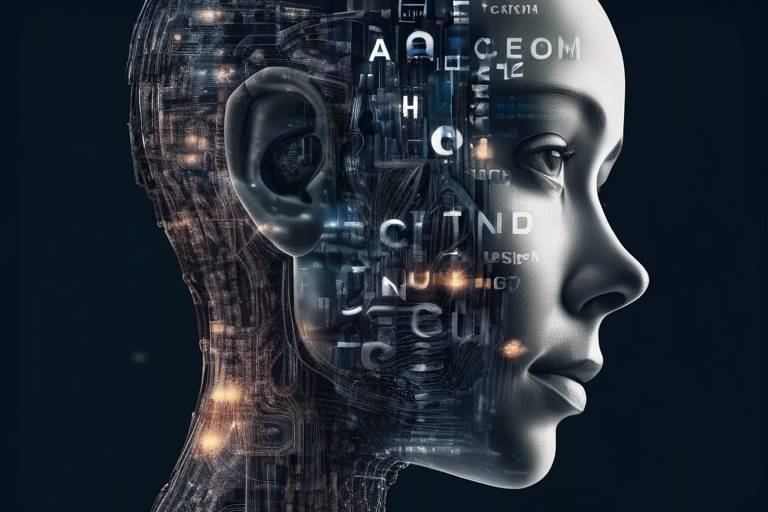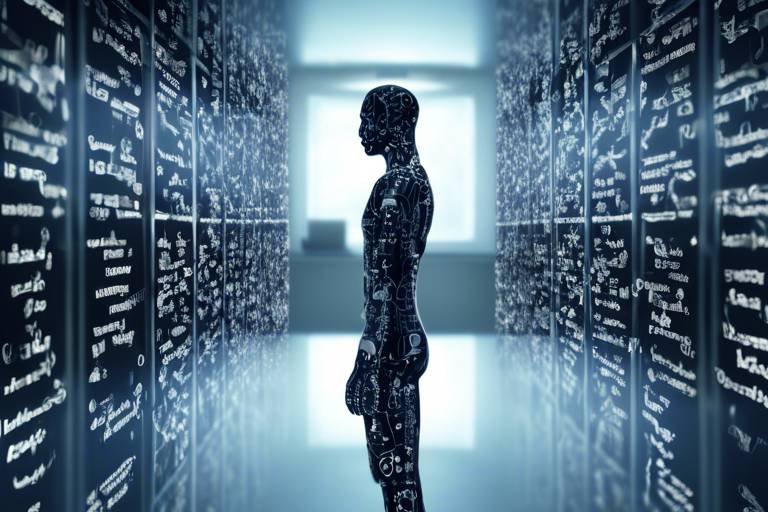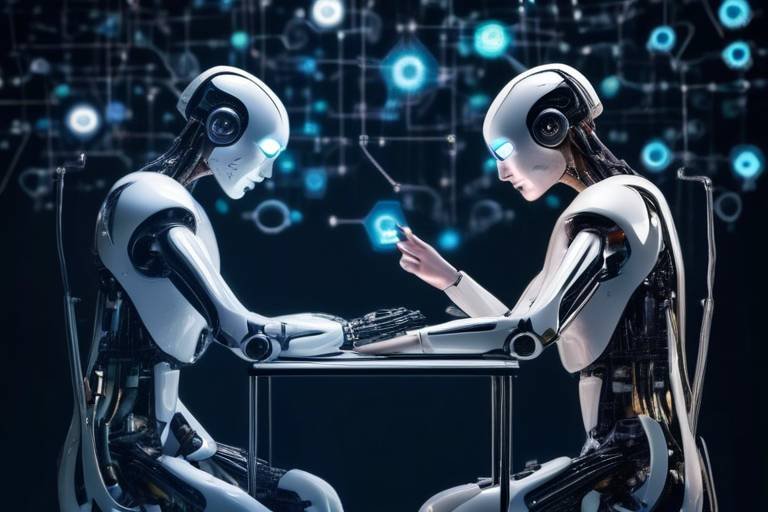Reimagining Human Collaboration using AI
In today's fast-paced world, the way we collaborate is undergoing a profound transformation, largely thanks to the advent of artificial intelligence (AI). Imagine a workspace where mundane tasks are automated, communication barriers are obliterated, and creativity flourishes like never before. This is not just a dream; it's becoming a reality as AI technologies are integrated into our daily collaborative efforts. From enhancing communication to boosting productivity and sparking creativity, AI is reshaping how we work together.
Think about it: have you ever been bogged down by endless emails, miscommunications, or scheduling conflicts? With AI, these challenges can be significantly minimized. AI tools are designed to take over repetitive tasks, allowing team members to focus on what truly matters—creating, innovating, and achieving goals. As we delve deeper into this exciting topic, we will explore the potential of AI in transforming teamwork and the challenges that come with it.
Furthermore, the integration of AI into collaboration is not just about technology; it's about people. It's about how we interact, share ideas, and solve problems together. As we navigate through this article, we'll highlight various AI-driven solutions that are enhancing team dynamics and communication. We'll also address the challenges of AI integration, including resistance to change and ethical considerations that must be taken into account. So, buckle up as we embark on this journey to discover how AI is reimagining human collaboration!
Understanding the influence of AI tools on team interactions and relationships is crucial for fostering effective collaboration. AI can have a profound impact on team dynamics, both positively and negatively. On the upside, AI can streamline workflows, enhance communication, and even help in resolving conflicts by providing data-driven insights. For instance, AI analytics can identify patterns in team interactions that may lead to misunderstandings, allowing teams to address issues proactively.
However, there are potential drawbacks to consider. The introduction of AI tools can sometimes lead to feelings of alienation among team members, especially for those who may feel threatened by technology. It’s essential to strike a balance and ensure that AI acts as a supportive partner rather than a replacement. By fostering an environment where human input is valued alongside AI suggestions, teams can create a harmonious blend that maximizes both efficiency and creativity.
Communication is the backbone of any successful team, and AI communication platforms are revolutionizing how teams connect and share information. These tools are designed to enhance communication efficiency and clarity among team members, making it easier to collaborate regardless of geographical barriers. For instance, AI-powered chatbots can facilitate instant communication, answering queries and providing information without delay.
Virtual assistants are becoming invaluable in streamlining collaborative efforts. Imagine having a digital assistant that manages your schedule, sets reminders, and even helps draft emails. This not only reduces the administrative burden on team members but also fosters a more productive environment. With less time spent on logistical challenges, teams can focus on creative problem-solving and innovation.
AI can automate scheduling and task management, allowing teams to focus on creative problem-solving rather than logistical challenges. Tools like Calendly or Trello use AI to optimize schedules and manage tasks efficiently. This means less back-and-forth communication and more time for actual collaboration. Imagine a scenario where your virtual assistant finds the best time for a team meeting based on everyone's availability, all while you focus on brainstorming your next big project.
In our increasingly globalized world, real-time translation tools powered by AI are breaking down language barriers, enabling diverse teams to collaborate seamlessly. These tools allow team members from different linguistic backgrounds to communicate effectively, enhancing the overall collaborative experience. Picture a team with members from various countries, all contributing their unique perspectives without the hindrance of language differences. This not only fosters creativity but also promotes a culture of inclusivity.
AI can augment human creativity by providing insights and suggestions, leading to innovative solutions. Imagine having an AI tool that analyzes market trends and provides recommendations for your next product launch. This section discusses how AI tools can inspire and support creative collaboration, enabling teams to think outside the box and push the boundaries of innovation.
While AI offers numerous benefits, its integration into collaborative environments comes with challenges. Resistance to change is a common hurdle that teams face when adopting new technologies. Many team members may feel apprehensive about using AI tools, fearing that it might replace their jobs or complicate their workflows. It’s essential to address these concerns head-on, providing training and support to help team members feel comfortable with the new tools.
To overcome resistance, it’s crucial to foster a culture of openness and adaptability. Encourage team members to share their concerns and experiences with AI, creating a dialogue that promotes understanding. Providing training sessions and showcasing the benefits of AI can also help alleviate fears. When team members see the tangible advantages of AI—like increased productivity and reduced workload—they are more likely to embrace the change.
The use of AI in collaboration raises important ethical questions regarding privacy, data security, and bias. As teams leverage AI tools, it's vital to ensure that data is handled responsibly and that AI systems are free from biases that could impact decision-making. Addressing these ethical implications is essential for building trust and ensuring that AI serves as a beneficial tool for all team members.
- How can AI improve team productivity?
AI can automate repetitive tasks, streamline communication, and provide data-driven insights, allowing teams to focus on their core responsibilities. - What are the potential downsides of using AI in collaboration?
Some team members may feel threatened by AI, leading to resistance. Additionally, there are ethical concerns regarding data privacy and bias that need to be addressed. - Can AI help with creativity?
Yes! AI can provide insights and suggestions that inspire innovative thinking and help teams generate new ideas.

The Role of AI in Team Dynamics
In today's fast-paced work environment, understanding the role of AI in team dynamics is more crucial than ever. As organizations increasingly adopt artificial intelligence, the way teams interact and collaborate is undergoing a profound transformation. Imagine a workplace where mundane tasks are handled by intelligent systems, allowing team members to focus on what truly matters: creativity, innovation, and problem-solving. This shift not only enhances productivity but also fosters a more collaborative atmosphere. However, it’s essential to recognize both the benefits and the potential drawbacks of integrating AI into team dynamics.
One of the most significant advantages of AI in team settings is its ability to facilitate effective communication. AI tools can analyze communication patterns and provide insights that help team members understand each other better. For instance, AI can suggest optimal times for meetings based on individual schedules, ensuring that everyone is on the same page. This proactive approach helps in minimizing misunderstandings and fosters a sense of unity within the team.
However, the introduction of AI is not without its challenges. Some team members may feel threatened by AI's capabilities, fearing that their roles might be diminished or replaced. This fear can lead to resistance, which can create friction within the team. To mitigate these concerns, it is essential for organizations to emphasize that AI is here to assist, not replace. By positioning AI as a tool that enhances human capabilities rather than undermines them, teams can cultivate a more positive attitude towards AI integration.
Moreover, the integration of AI can also lead to changes in team relationships. With AI handling repetitive tasks, team members can spend more time engaging in meaningful discussions and brainstorming sessions. This shift can enhance collaboration, as individuals are encouraged to share ideas and work together more effectively. However, it is vital to maintain a balance; over-reliance on AI could lead to a decline in interpersonal skills, which are essential for any successful team.
In summary, the role of AI in team dynamics is multifaceted. It can enhance communication, improve productivity, and foster creativity, but it also presents challenges that need to be addressed. Organizations must navigate this landscape carefully, ensuring that AI serves as a catalyst for collaboration rather than a barrier. By doing so, teams can harness the full potential of AI, transforming their collaborative efforts into something truly remarkable.

AI-Driven Communication Tools
In the rapidly evolving landscape of teamwork, have emerged as game-changers, fundamentally altering how teams connect and share information. Imagine a world where geographical boundaries dissolve, and collaboration feels as natural as a conversation over coffee. That's the promise of AI! These tools not only enhance efficiency but also bring a new level of clarity to communication, making it easier for teams to stay on the same page.
One of the most significant advantages of AI communication tools is their ability to streamline conversations. For instance, platforms like Slack and Microsoft Teams have integrated AI features that help prioritize messages, suggest responses, and even summarize discussions. This means that team members can quickly catch up on what they missed without sifting through endless threads. It's like having a personal assistant who knows exactly what you need to know!
Moreover, AI tools can analyze communication patterns and provide insights into team dynamics. They can identify when team members are most engaged or when discussions tend to stall. By leveraging this data, teams can adjust their communication strategies to be more effective. For example, if a team notices that meetings are often unproductive during a certain time of day, they might consider rescheduling to boost engagement.
Another exciting development in AI-driven communication is the rise of chatbots. These virtual assistants can handle routine inquiries, freeing up human team members to focus on more complex tasks. Imagine a scenario where a team member needs information about a project deadline or company policy. Instead of searching through emails or documents, they can simply ask a chatbot, which provides instant answers. This not only saves time but also reduces frustration, allowing teams to concentrate on what truly matters.
Furthermore, AI-driven tools can help bridge communication gaps in diverse teams. With features like real-time language translation, teams can collaborate seamlessly, regardless of their native languages. This capability is particularly beneficial in global organizations where team members may come from various cultural backgrounds. By enabling clear communication, AI fosters a more inclusive environment where every voice is heard.
However, it’s essential to recognize that while AI tools offer remarkable benefits, they are not without their challenges. As teams increasingly rely on these technologies, they must also consider the implications of data privacy and security. Trusting AI with sensitive information requires robust safeguards to protect against breaches and misuse. It's crucial for organizations to implement strong data governance policies and ensure that team members are trained on how to use these tools responsibly.
In summary, AI-driven communication tools are reshaping the way teams interact, leading to enhanced productivity and creativity. By automating mundane tasks, providing insightful analytics, and breaking down language barriers, these tools empower teams to focus on collaboration and innovation. As we embrace this technological revolution, the potential for improved teamwork is limitless!
- What are AI-driven communication tools?
AI-driven communication tools are software applications that use artificial intelligence to enhance how teams communicate, share information, and collaborate. - How do AI tools improve team productivity?
AI tools automate routine tasks, prioritize messages, and provide insights into communication patterns, allowing teams to focus on more critical activities. - Can AI tools help with language barriers?
Yes! AI-driven real-time translation tools enable team members who speak different languages to communicate effectively and collaborate seamlessly. - What are the potential risks of using AI communication tools?
Potential risks include data privacy concerns, security vulnerabilities, and the need for team members to adapt to new technologies.

Virtual Assistants in Collaboration
In today's fast-paced work environment, virtual assistants have emerged as indispensable allies in enhancing collaboration among team members. These intelligent tools are not just programmed to handle mundane tasks; they are designed to streamline communication, manage schedules, and facilitate teamwork in ways that were once unimaginable. Imagine having a digital partner that can not only remind you of your meetings but also analyze your calendar to suggest the best times for collaborative brainstorming sessions. Sounds like science fiction, right? But it's very much a reality.
One of the most significant benefits of integrating virtual assistants into collaborative efforts is their ability to reduce administrative burdens. For instance, instead of spending precious time coordinating schedules through endless email threads, team members can rely on AI-powered tools to automate these processes. This allows everyone to focus on what truly matters: creative problem-solving and innovation. Consider a scenario where a project team is working against a tight deadline. A virtual assistant can quickly identify available time slots for all team members, send out calendar invites, and even provide reminders, thus ensuring that everyone is on the same page.
Moreover, virtual assistants can help in managing tasks by prioritizing them based on urgency and importance. When team members are juggling multiple responsibilities, it’s easy for tasks to fall through the cracks. With AI tools, tasks can be assigned, monitored, and adjusted in real-time, providing a clear overview of project progress. This transparency fosters accountability and encourages team members to stay engaged. For example, a virtual assistant could generate a
summary of tasks assigned to each team member, highlighting deadlines and completion rates, making it easier to keep track of who is doing what:| Team Member | Task | Deadline | Status |
|---|---|---|---|
| Alice | Design Mockup | Oct 10 | In Progress |
| Bob | Write Proposal | Oct 12 | Completed |
| Carol | Market Research | Oct 15 | Not Started |
Another fascinating aspect of virtual assistants is their ability to facilitate communication across different platforms. With the rise of remote work, teams often find themselves using various communication tools. A virtual assistant can function as a bridge, ensuring that messages and updates are relayed seamlessly, regardless of the platform being used. This capability not only enhances efficiency but also fosters a sense of unity among team members, making them feel more connected despite physical distances.
However, it's essential to remember that while virtual assistants are powerful tools, they are most effective when used to complement human efforts rather than replace them. The human touch in collaboration—empathy, creativity, and intuition—is irreplaceable. Virtual assistants should be viewed as partners that empower teams to achieve greater heights, allowing individuals to focus on strategic thinking and innovation rather than getting bogged down in administrative tasks.
In conclusion, the role of virtual assistants in collaboration is transformative. They not only streamline processes but also enhance productivity and creativity within teams. As we continue to embrace these technologies, we must also remain aware of the need for balance, ensuring that human connections remain at the forefront of our collaborative efforts.
- What are virtual assistants? - Virtual assistants are AI-powered tools designed to help with administrative tasks, scheduling, and communication.
- How can virtual assistants improve team collaboration? - They streamline communication, automate scheduling, and help manage tasks efficiently.
- Are virtual assistants replacing human jobs? - No, they are intended to complement human efforts, allowing people to focus on more strategic tasks.
- Can virtual assistants work across different platforms? - Yes, they can facilitate communication among various tools and platforms.

Scheduling and Task Management
In today's fast-paced world, effective scheduling and task management are essential for any team aiming to maximize productivity and foster creativity. Imagine a scenario where your team is juggling multiple projects, deadlines are looming, and everyone is trying to coordinate their schedules. It can feel like a chaotic juggling act, right? This is where AI-driven tools come into play, transforming the way teams manage their time and tasks. These tools not only streamline the process but also alleviate the burden of administrative tasks, allowing team members to focus on what truly matters—innovation and collaboration.
AI-powered scheduling tools can automate the process of finding suitable meeting times, sending reminders, and even rescheduling when conflicts arise. For instance, platforms like Calendly and Google Calendar integrate AI to analyze participants' availability and suggest optimal meeting times. This means less back-and-forth communication and more time spent on productive discussions. Additionally, these tools can learn from past interactions, continuously improving their suggestions and making the scheduling process even more efficient.
Moreover, task management tools such as Trello and Asana leverage AI to prioritize tasks based on deadlines, team member workloads, and project requirements. This not only helps in keeping everyone on track but also ensures that the most critical tasks are highlighted. Imagine having a digital assistant that can remind you of your priorities and deadlines without you having to lift a finger! This is the power of AI in scheduling and task management—it's like having a personal assistant dedicated to making your team run smoother.
However, it’s essential to approach these tools with a strategy. While AI can significantly enhance productivity, teams must also be aware of the potential pitfalls, such as over-reliance on technology or the risk of losing the personal touch in communication. Striking the right balance is key. To ensure that your team reaps the full benefits of AI, consider the following:
- Training and Onboarding: Provide comprehensive training for team members to familiarize them with the tools.
- Feedback Loops: Establish channels for team members to share their experiences and suggest improvements.
- Regular Check-ins: Schedule periodic reviews to assess how well the tools are meeting the team's needs.
By integrating AI into your scheduling and task management processes, you’re not just adopting new technology; you’re embracing a smarter way of working. It’s about freeing up time for creativity, enhancing collaboration, and ultimately driving your team's success. So, the next time you're faced with a scheduling nightmare, remember that AI is here to help you turn chaos into order!
Q: How can AI improve our team's scheduling process?
A: AI can automate the scheduling process by analyzing team members' availability and suggesting optimal meeting times, reducing the need for back-and-forth communication.
Q: What are some popular AI-driven task management tools?
A: Some popular tools include Trello, Asana, and Monday.com, which utilize AI to prioritize tasks and streamline project management.
Q: Are there any risks associated with using AI for scheduling?
A: Yes, potential risks include over-reliance on technology, which can lead to a lack of personal interaction, and challenges in adapting to new systems.
Q: How can we ensure our team is comfortable using AI tools?
A: Providing training, encouraging feedback, and having regular check-ins can help team members feel more comfortable and engaged with AI tools.

Real-Time Language Translation
Imagine a world where language barriers crumble, allowing teams from different corners of the globe to collaborate effortlessly. powered by artificial intelligence is making this dream a reality, transforming the way we communicate in diverse teams. These innovative tools not only facilitate seamless conversations but also enhance understanding and foster creativity among team members who may speak different languages.
AI-driven translation tools work by utilizing advanced algorithms and machine learning to interpret and translate spoken or written language almost instantaneously. This means that whether you're in a meeting with colleagues from Tokyo, Paris, or New York, you can communicate as if you were all speaking the same language. The implications of this technology are profound, as it opens up opportunities for collaboration that were previously hindered by linguistic differences.
Consider the following benefits of real-time language translation in collaborative environments:
- Enhanced Communication: Misunderstandings can lead to costly errors. Real-time translation ensures that every team member is on the same page, reducing the risk of miscommunication.
- Increased Inclusivity: Teams can consist of individuals from various backgrounds. Language translation tools make it easier for everyone to contribute, fostering a more inclusive environment.
- Broader Talent Pool: Companies can hire talent from around the world without the constraint of language barriers, allowing them to tap into a diverse range of skills and perspectives.
However, while the benefits are significant, it's essential to recognize that technology is not infallible. AI translation tools can sometimes struggle with context, idiomatic expressions, or cultural nuances. Therefore, it’s crucial for teams to remain patient and open-minded, understanding that these tools are designed to assist, not replace, human communication. By combining the capabilities of AI with human empathy and understanding, teams can create a collaborative atmosphere that thrives on diversity and innovation.
In conclusion, real-time language translation is not just a technological advancement; it’s a bridge connecting cultures and ideas. As teams embrace these tools, they can unlock new levels of collaboration and creativity that were once thought impossible. So, the next time you find yourself in a meeting with team members from around the world, remember that with the power of AI, the only limit is your imagination.
Q1: How accurate are real-time language translation tools?
A1: While AI translation tools have improved significantly, they may not always capture the full context or nuances of a conversation. It's important to use them as a supplement to human communication.
Q2: Can these tools handle technical jargon?
A2: Many AI translation tools are being trained on specific industries to better understand technical language, but it's always a good idea to double-check critical communications with a human expert when necessary.
Q3: Are there any privacy concerns with using AI translation tools?
A3: Yes, privacy is a significant concern. It's essential to choose reputable tools that prioritize data security and ensure that sensitive information is not stored or misused.

Enhancing Creativity with AI
In today's fast-paced world, creativity is the lifeblood of innovation. But what if we told you that artificial intelligence (AI) can be your secret weapon in unleashing that creative potential? Imagine having a brainstorming partner that never tires, always offers fresh perspectives, and can analyze vast amounts of data in seconds. Sounds like a dream, right? Well, it's becoming a reality! AI tools are not just for automating mundane tasks; they are transforming how we approach creative collaboration.
AI can significantly enhance creativity by providing insights and suggestions that might not have been considered otherwise. For instance, tools like GPT-4 can generate ideas based on keywords or themes you provide. This opens up a world of possibilities, allowing teams to explore concepts they may not have thought of. It's like having a creative assistant that can think outside the box while you focus on refining and executing those ideas.
Moreover, AI can analyze trends and patterns in various industries, helping teams stay ahead of the curve. By processing data from social media, market reports, and consumer feedback, AI can highlight emerging trends that teams can capitalize on. This ability to predict what’s next is invaluable for any creative team looking to innovate and make an impact.
Another exciting aspect of AI in creative collaboration is its capacity for personalization. AI can tailor suggestions based on individual team members' strengths and preferences, creating a more engaged and motivated team. For example, if a team member excels at graphic design, AI can suggest design elements or styles that align with their skills, thus enhancing the overall output of the project.
But how exactly does this work? Here are a few key ways AI enhances creativity:
- Idea Generation: AI tools can analyze existing content and generate new ideas, helping teams break through creative blocks.
- Feedback and Iteration: AI can provide instant feedback on creative work, allowing teams to iterate quickly and improve their concepts.
- Collaborative Platforms: AI enhances collaborative platforms by suggesting connections between team members based on their skills and past projects, fostering a more cohesive creative environment.
As we embrace these technologies, it's crucial to remember that AI is a tool designed to augment human creativity, not replace it. The magic happens when humans and machines work together, each bringing their unique strengths to the table. Just like an artist uses brushes and colors to create a masterpiece, teams can use AI to unlock their full creative potential.
In summary, the integration of AI into creative processes is not just a trend; it's a transformative shift that can redefine how we collaborate. As we move forward, embracing these tools will enable us to create innovative solutions that resonate in an increasingly competitive landscape. So, are you ready to harness the power of AI and take your creativity to the next level?
- How does AI assist in the creative process? AI assists by providing data-driven insights, generating ideas, and offering personalized suggestions based on team members' strengths.
- Can AI replace human creativity? No, AI is designed to augment human creativity, providing tools that enhance collaboration but not replacing the unique human touch.
- What are some examples of AI tools for creativity? Some popular AI tools include GPT-4 for idea generation, Adobe Sensei for design assistance, and various analytics tools for trend spotting.

Challenges of AI Integration
As we embrace the transformative power of artificial intelligence (AI), it’s essential to recognize that its integration into collaborative environments is not without its challenges. While the benefits of AI are compelling, the journey toward effective implementation can be riddled with obstacles that teams must navigate. One of the most significant challenges is resistance to change. Many team members may feel apprehensive about adopting new technologies, often due to a fear of the unknown or a misunderstanding of AI’s capabilities. This resistance can manifest in various ways, from skepticism about the technology itself to concerns about job security.
To tackle this issue, organizations must prioritize education and training. By providing team members with the necessary knowledge and skills to utilize AI tools effectively, companies can foster a culture of acceptance and enthusiasm. Workshops, seminars, and hands-on training sessions can help demystify AI, illustrating its potential to enhance rather than replace human contributions. Furthermore, involving team members in the selection and implementation process can create a sense of ownership and alleviate fears.
Another pressing challenge is the ethical considerations surrounding AI collaboration. As AI systems often rely on vast amounts of data, questions regarding privacy, data security, and bias come to the forefront. For instance, how can teams ensure that sensitive information remains confidential when using AI-driven tools? Moreover, AI algorithms can inadvertently perpetuate biases present in the data they are trained on, leading to skewed outcomes that can affect decision-making.
To address these ethical concerns, organizations must establish clear guidelines and protocols for AI usage. This includes implementing robust data protection measures, conducting regular audits of AI systems for bias, and fostering an open dialogue about ethical practices among team members. By prioritizing transparency and accountability, organizations can build trust in AI technologies and encourage a collaborative environment where ethical considerations are at the forefront.
Lastly, the integration of AI into teamwork often requires a shift in organizational culture. Traditional structures may not be conducive to the fluid, dynamic interactions that AI tools can facilitate. Teams may need to adopt more agile methodologies, encouraging collaboration across departments and breaking down silos that hinder communication. This cultural shift can be challenging, as it involves rethinking established processes and encouraging a mindset that embraces innovation and flexibility.
In conclusion, while the integration of AI into collaboration presents several challenges, these hurdles are not insurmountable. By focusing on education, ethical practices, and cultural transformation, organizations can harness the full potential of AI, paving the way for enhanced teamwork and productivity. The key lies in approaching these challenges with a proactive mindset, ensuring that both technology and team members can thrive in a collaborative landscape.
- What are the main challenges of integrating AI into teams?
Resistance to change, ethical concerns, and the need for cultural transformation are among the primary challenges. - How can organizations overcome resistance to AI adoption?
Education, training, and involving team members in the process can help ease fears and promote acceptance. - What ethical considerations should be addressed when using AI?
Organizations should focus on privacy, data security, and bias in AI systems to ensure ethical collaboration.

Addressing Resistance to Change
Change is often met with skepticism, and when it comes to integrating artificial intelligence into collaborative environments, this resistance can be particularly pronounced. Many team members may feel threatened by the introduction of AI tools, fearing that their roles could be diminished or that they might struggle to adapt to new technologies. To effectively address this resistance, it’s essential to foster an environment of understanding and trust.
One effective strategy is to involve team members in the decision-making process. When individuals feel they have a voice in the adoption of new tools, they are more likely to embrace the change. This can be achieved through workshops or brainstorming sessions where team members can express their concerns and share ideas on how AI can enhance their work. Additionally, providing clear communication about the benefits of AI—such as increased productivity and reduced administrative burdens—can help alleviate fears. For instance, when team members understand that AI can handle mundane tasks, they can focus more on creative problem-solving and innovation.
Moreover, offering training sessions can empower employees to become proficient with AI tools. This not only boosts their confidence but also demonstrates that the organization is committed to their professional growth. Consider implementing a mentorship program where tech-savvy team members can guide others through the learning curve. This approach not only builds camaraderie but also facilitates knowledge sharing, making the transition smoother.
It's also important to recognize that change takes time. Gradual implementation of AI tools can help ease the transition. Rather than an abrupt shift, introducing AI in phases allows team members to adjust and provide feedback along the way. This iterative approach can lead to a more positive reception as employees witness the incremental benefits firsthand.
Lastly, addressing the emotional aspect of change is vital. Acknowledge the feelings of uncertainty and fear that team members may experience. Creating a supportive atmosphere where individuals can voice their concerns without judgment can go a long way in building resilience. Regular check-ins and open forums can help maintain an ongoing dialogue about the integration of AI, ensuring that everyone feels heard and valued.
In summary, addressing resistance to change involves a multifaceted approach that includes clear communication, training, gradual implementation, and emotional support. By fostering a culture that embraces innovation while respecting individual concerns, organizations can successfully navigate the challenges of AI integration and unlock its full potential in enhancing collaboration.
- What are some common fears regarding AI integration? Many employees worry about job displacement, the complexity of new tools, and the potential for increased surveillance.
- How can I support my team during the transition? Provide training, involve them in decision-making, and maintain open lines of communication.
- What if some team members refuse to adopt AI tools? Address their concerns directly, offer additional support, and highlight the benefits of AI.

Ethical Considerations in AI Collaboration
As we delve into the realm of AI collaboration, it becomes increasingly important to address the ethical considerations that accompany this technological shift. The integration of AI into teamwork raises profound questions regarding privacy, data security, and bias. These issues are not just technicalities; they significantly impact how teams interact and trust one another in an AI-enhanced environment.
First and foremost, let’s talk about privacy. With AI tools collecting and analyzing vast amounts of data, team members might feel that their personal information is at risk. This concern is heightened in remote work settings, where AI systems often monitor activities and productivity levels. Organizations must ensure that their AI tools are transparent about what data is collected and how it’s used. This transparency fosters a culture of trust, allowing team members to feel secure in their collaborative efforts.
Next, we have data security. The more we rely on AI systems, the more we expose ourselves to potential cyber threats. A data breach can not only compromise sensitive information but also damage the integrity of the entire collaborative process. Companies must prioritize robust security measures, such as encryption and regular audits, to protect their data. By implementing stringent security protocols, organizations can mitigate risks and reassure team members that their information is safe.
Then, there’s the issue of bias. AI systems are only as good as the data they are trained on. If that data reflects existing biases, the AI can perpetuate these biases in its recommendations and actions. This is particularly concerning in diverse teams where equitable collaboration is paramount. It’s essential for organizations to actively monitor AI outputs and ensure that they promote inclusivity rather than exclusion. By regularly evaluating AI performance and making necessary adjustments, teams can work towards a more equitable collaborative environment.
In summary, while AI offers exciting opportunities for enhancing collaboration, it also brings forth significant ethical challenges. Addressing these issues requires a proactive approach, where organizations prioritize transparency, security, and fairness in their AI integration strategies. Only then can we truly harness the full potential of AI in collaboration, paving the way for a future where technology and humanity work hand in hand.
- What are the main ethical concerns regarding AI collaboration? The primary concerns include privacy, data security, and bias in AI systems.
- How can organizations ensure data privacy when using AI? Organizations should be transparent about data collection practices and implement strict security measures to protect sensitive information.
- What steps can be taken to address bias in AI? Regular monitoring and evaluation of AI outputs can help identify and mitigate biases, promoting a more equitable collaborative environment.
- Why is transparency important in AI collaboration? Transparency fosters trust among team members, ensuring that they feel secure in their collaborative efforts and confident in the AI tools being used.
Frequently Asked Questions
- How does AI enhance team collaboration?
AI enhances team collaboration by providing tools that streamline communication, automate scheduling, and manage tasks efficiently. This allows team members to focus more on creative problem-solving rather than getting bogged down by administrative tasks.
- What are some examples of AI-driven communication tools?
Some popular AI-driven communication tools include chatbots, virtual assistants, and platforms that facilitate real-time language translation. These tools help teams connect and share information seamlessly, making collaboration smoother and more effective.
- Can AI help in managing tasks and schedules?
Absolutely! AI can automate scheduling and task management, reducing the time spent on logistical challenges. This means teams can allocate more time to brainstorming and executing innovative ideas.
- What role do virtual assistants play in collaboration?
Virtual assistants play a crucial role in managing schedules, sending reminders, and facilitating communication among team members. They act as a support system that helps teams stay organized and focused on their goals.
- How does AI support creativity in teams?
AI supports creativity by providing insights, suggestions, and data-driven inspiration. This can lead to innovative solutions and a more dynamic brainstorming process, enhancing the overall creative output of the team.
- What challenges might teams face when integrating AI?
Teams may face challenges such as resistance to change, misunderstandings about AI capabilities, and ethical concerns regarding privacy and data security. It's important to address these issues through education and open communication.
- How can teams overcome resistance to AI adoption?
To overcome resistance, teams can provide training sessions, share success stories, and encourage open discussions about AI's benefits. Building a culture of trust and transparency can significantly ease the transition.
- What ethical considerations should teams keep in mind with AI?
Teams should be aware of ethical considerations such as data privacy, potential biases in AI algorithms, and the impact of AI decisions on team dynamics. It's crucial to establish guidelines that prioritize ethical practices in AI usage.

